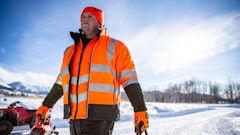
This blog was updated on 6/6/2023.
What’s causes accidents on construction sites? The Occupational Safety & Health Administration (OSHA) has narrowed it down to four main hazards and recommends these steps to help prevent them.
1. Falls
OSHA includes both falls from heights and slips and trips in this category. Most falls on construction sites are the result of uneven surfaces, improper mounting and dismounting from equipment, improper ladder use or lack of fall-protection equipment. Slips and trips are often caused by misplaced items or spills and leaks. To prevent falls:
- Keep work areas clean, clear of clutter and well lit.
- Use three points of contact when mounting and dismounting equipment.
- Make sure employees wear shoes with adequate traction.
- Follow safety regulations for ladders (and train employees on these rules).
- Use appropriate fall equipment — guardrails, personal fall arrest systems and safety nets.
2. Struck By an Object
OSHA defines this type of injury as the impact between a person and an object or piece of equipment — being hit by a machine or falling materials, for example. The keys to avoiding struck-by injuries are clearly marking or blocking off vulnerable areas and wearing proper personal protective equipment (PPE). You should also:
- Stack materials properly to avoid falling and sliding objects.
- Avoid close proximity to lifted or suspended loads.
- Train employees not to position themselves between fixed and moving objects.
- Secure materials and tools properly so they won’t fall.
- Avoid driving in reverse if your view is obstructed.
- Verify a reverse signal (backup) alarm is installed and functioning properly on all mobile equipment.
3. Electrocution
Burns are the most common result of electrocution, but it can also lead to cardiac arrest and nerve damage. OSHA regulations focus on covering requirements, proper design and use of electrical equipment, and utilizing electrical protective devices and proper insulation. Other advice:
- Use all required PPE.
- De-energize equipment and use proper lockout and tag-out procedures.
- Train employees to keep a safe distance from parts that are energized.
4. Caught In/Between
These accidents occur when a worker is caught between two or more objects — if a vehicle traps a person against a wall, a body part is pulled into machinery or materials collapse on someone. Staying focused on your surroundings is the best way to prevent these injuries. Also:
- Don’t place yourself between heavy equipment and an immovable object.
- Don’t put your hands or other body parts near moving objects.
- Don’t wear long sleeves, jewelry or other items that can get caught on moving objects.
- Don’t work in unprotected excavation areas or where water is accumulating.
- Don’t get in the swing radius of a rotating object.
Preventing injuries caused by these hazards — as well as other accidents on the jobsite — starts with a culture that puts safety first. Need help assessing the state of your operation’s safety culture or access to tools that can help you improve it? Check out the resources available from Caterpillar Safety Services.
This blog was updated on 6/6/2023.



















